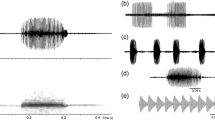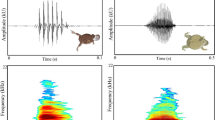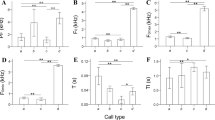Abstract
Sequences of the advertisement calls produced by male Nathusius’ pipistrelles (Pipistrellus nathusii) during the autumn mating period were recorded from individuals at two separate sites in Antrim, Northern Ireland, in August 2004. Several male roosts were found at these sites in close proximity to a single maternity roost, each containing approximately 200 adult females and their young. Analysis of measured parameters of four identified call types revealed that there were significant differences in call structure between sites and between individuals. Playback experiments, performed outside the adult female and juvenile roost sites, comprised of experimental advertisement call sequences of P. nathusii, Pipistrellus pygmaeus and Pipistrellus pipistrellus and control sound recorded without bats present (silence). Response was measured by simultaneously recording ultrasound during playbacks and counting the number of echolocation pulses identified as those of P. nathusii above a predetermined amplitude threshold. Significantly greater numbers of P. nathusii echolocation pulses were recorded during playback of male P. nathusii advertisement calls than during playback of congeners’ advertisement calls and control sound. The number of echolocation pulses recorded was similar during playback of P. pipistrellus and P. pygmaeus advertisement calls and silence. We suggest that, due to call complexity, male P. nathusii advertisement calls should be classified as ‘song’. Species-specificity and individual variation suggests that the songs of male P. nathusii have the potential to play a role in mate attraction and mate assessment.




Similar content being viewed by others
References
Ahlén I (1990) Identification of bats in flight. Swedish Society for the Conservation of Nature and the Swedish Youth Association for Environmental Studies and Conservation, Stockholm
Andersson S (1994) Costs of sexual advertising in the lekking Jackson’s widowbird. Condor 96:1–10
AOU (American Ornithologists’ Union) (1985) Thirty-fifth supplement to the American Ornithologists’ Union check-list of North American birds. Auk 102:680–686
Backwell PRY, Passmore NI (1990) Suitable approach perches affect female phonotaxis in an arboreal frog. Herpetologica 46:11–14
Backwell PRY, Passmore NI (1991) Advertisement calls and female phonotaxis in Natal dwarf Afrixalus. J Afr Zool 4:275–280
Baker MC, Cunningham MA (1985) The biology of bird-song dialects. Behav Brain Sci 8:85–133
Barlow KE, Jones G (1996) Pipistrellus nathusii (Chiroptera: Vespertilionidae) in Britain in the mating season. J Zool 240:767–773
Barlow KE, Jones G (1997) Differences in song-flight calls and social calls between two phonic types of the vespertilionid bat Pipistrellus pipistrellus. J Zool 241:315–324
Barratt EM, Deaville R, Burland TM, Bruford MW, Jones G, Racey PA, Wayne RK (1997) DNA answers the call of pipistrelle bat species. Nature 387:138–139
Becker PH (1982) The coding of species-specific characteristics in bird sounds. In: Kroodsma DE, Miller EH (eds) Acoustic communication in birds, vol 1. Academic, New York, pp 213–252
Behr O, von Helversen O (2004) Bat serenades—complex courtship songs of the sac-winged bat (Saccopteryx bilineata). Behav Ecol Sociobiol 56:106–115
Bjerke TH, Bjerke TH (1981) Song dialects in the redwing, Turdus iliacus. Ornis Scand 12:40–50
Boughman JW, Wilkinson GS (1998) Greater spear-nosed bats discriminate group mates by vocalizations. Anim Behav 55:1717–1732
Bradbury JW, Vehrencamp SL (1998) Principles of animal communication. Sinauer, Sunderland, MA
Catchpole CK (1987) Bird song, sexual selection and female choice. Trends Ecol Evol 2:94–97
Catchpole CK, Slater PJB (1995) Bird song: biological themes and variations. Cambridge University Press, Cambridge
Channing A, Moyer D, Burger M (2002) Cryptic species of sharp-nosed reed frogs in the Hyperolius nasutus complex: advertisement call differences. Afr Zool 21:91–99
Ciechanowski M, Jarzembowski T (2004) The size and number of harems in the polygynous bat Pipistrellus nathusii (Keyserling and Blasius, 1839) (Chiroptera: Vespertilionidae). Mamm Biol 69(4):277–280
Clayton NS (1990) Subspecies recognition and song learning in zebra finches. Anim Behav 40:1009–1017
Davidson SM, Wilkinson GS (2002) Geographic and individual variation in vocalizations by male Saccopteryx bilineata (Chiroptera: Emballonuridae). J Mamm 83:526–535
Davidson S, Wilkinson GS (2004) Function of male song in the greater white-lined bat, Saccopteryx bilineata. Anim Behav 67:883–891
Falls JB, d’Agincourt LG (1982) Why do meadowlarks switch song types? Can J Zool 60:3400–3408
Furmankiewicz J, Szkudlarek R (2001) The mating roosts of Nathusius’ pipistrelle males Pipistrellus nathusii (Keyserling and Blasius 1839) in Wroclaw (SW Poland). In: Woloszyn BW (ed) Distribution, ecology, paleontology and systematics of bats. Bats & man: million years of coexistence. Chiropterological Information Center, Krakow, pp 47–57
Gerell-Lundberg K, Gerell R (1994) The mating behaviour of the pipistrelle and the Nathusius’ pipistrelle (Chiroptera)—a comparison. Folia Zool 43:315–324
Häussler U, Nagel A, Braun M, Arnold A (1999) External characters discriminating species of European pipistrelles, Pipistrellus pipistrellus (Schreber 1774) and P. pygmaeus (Leach 1825). Myotis 37:27–40
Houtman AM (1992) Female zebra finches choose extra-pair copulations with genetically attractive mates. Proc R Soc Lond B Biol Sci 249:3–6
Jarzembowski T, Stepniewska A (1998) Migration of the Nathusius’ pipistrelle Pipistrellus nathusii along Baltic coast. In: 11th international bat research conference, Departamento de Zoologia, Universidade de Brasilia, Pirenopolis, 41
Jones G, van Parijs SM (1993) Biomodal echolocation in pipistrelle bats: are cryptic species present? Proc R Soc Lond B Biol Sci 251:119–125
Kapteyn K, Lina PHC (1994) First record of a nursery roost of Nathusius’ pipistrelle, Pipistrellus nathusii, in the Netherlands. Lutra 37:106–109
Krebs JR, Ashcroft R, Webber M (1978) Song repertoires and territory defence in great tit. Nature 271:539–542
Laiolo P, Rolando A, Delestrade A, Sanctis A (2001) Geographic diversification in the call repertoire of the genus Pyrrhocorax (Aves, Corvidae). Can J Zool 79:1568–1576
Lambrechts M, Dhondt AA (1988) Male quality and territory quality in the great tit Parus major. Anim Behav 36:596–601
Lambrechts MM, Dhondt AA (1990) A relationship between the composition and size of great tit song repertoires. Anim Behav 39:213–218
Lundberg K (1989) Social organization and survival of the pipistrelle bat (Pipistrellus pipistrellus), and a comparison of advertisement behaviour in three polygynous bat species. Ph.D. Thesis, Lund University
Lundberg K, Gerell R (1986) Territorial advertisment and mate attraction in the bat Pipistrellus pipistrellus. Ethology 71(2):115–124
Matessi G, Dabelsteen T, Pilastro A (2000) Responses to playback of different subspecies songs in the Reed Bunting Emberizas. schoeniclus. J Avian Biol 31:96–101
Nuechterlein GL (1981) Courtship behavior and reproductive isolation between Western Grebe color morphs. Auk 98:335–349
Pallett JR, Passmore NI (1988) The significance of multi-note advertisement calls in a reed frog. Hyperolius tuberilinguis. Bioacoustics 1:13–23
Racey PA (1974) Ageing and assesment of reproductive status of pipistrelle bats (P. pipistrellus). J Zool 173:264–271
Russ JM, O’Neill JK, Montgomery WI (1998a) Nathusius’ pipistrelle (Pipistrellus nathusii), Keyserling and Blasius 1839) breeding in Ireland. J Zool 245:345–349
Russ JM, Racey PA, Jones G (1998b) Intraspecific responses to distress calls of the pipistrelle bat, Pipistrellus pipistrellus. Anim Behav 55:705–713
Russ JM, Hutson AM, Montgomery WI, Racey PA, Speakman JR (2001) The status of Nathusius’ pipistrelle (Pipistrellus nathusii) Keyserling and Blasius 1839) in the British Isles. J Zool 254:91–100
Russ JM, Jones G, Mackie IJ, Racey PA (2004) Interspecific responses to distress calls in bats (Chiroptera: Vespertilionidae): a function for convergence in call design? Anim Behav 67:1005–1014
Russ JM, Jones G, Racey PA (2005) Responses of soprano pipistrelles, Pipistrellus pygmaeus, to their experimentally modified distress calls. Anim Behav 70:393–404
Russo D, Jones G (1999) The social calls of Kuhl’s pipistrelles Pipistrellus kuhlii (Kuhl 1819): structure and variation. J Zool 249:476–481
Ryan MJ, Keddy-Hector A (1992) Directional patterns of female mate choice and the role of sensory biases. Am Nat 139:S4–S35
Searcy WA, Andersson M (1986) Sexual selection and the evolution of song. Ann Rev Ecolog Syst 17:507–533
Sender T, Roedenbeck I, Hampl S, Ferreri M, Simon M (2002) Revision of morphological identification of pipistrelle bat phonic types (Pipistrellus pipistrellus Schreber 1774). Myotis 40:11–17
Simmons LW (1987) Heritability of a male character chosen by females of the field cricket Gryllus bimaculatus (deGaer). Anim Behav 38:68–77
Speakman JR, Racey PA (1991) No cost of echolocation for bats in flight. Nature 350:421–423
Strelkov PP (1997a) Breeding area and its position in range of migratory bats species (Chiroptera, Vespertilionidae) in east Europe and adjacent territories. Communication 1. Zool Z 76:1073–1082
Strelkov PP (1997b) Breeding area and its position in range of migratory bats species (Chiroptera, Vespertilionidae) in east Europe and adjacent territories. Communication 2. Zool Z 76:1381–1390
Vaughan N, Jones G, Harris S (1997) Identification of British bat species by multivariate analysis of echolocation call parameters. Bioacoustics 7:189–207
von Helversen O, von Helversen D (1994) Forces driving coevolution of song and song recognition in grasshoppers. Folia Zool 43:331–338
Von Helversen O, Holderied M (2003) Zur Unterscheidung von Zwergfledermaus (Pipistrellus pipistrellus) und Mückenfledermaus (Pipistrellus mediterraneus/pygmaeus) im Feld. Nyctalus 8:420–426
Yalden DW (1985) The identification of British bats London. The Mammal Society, London
Yasukawa K, Blank JL, Patterson CB (1980) Song repertoire and sexual selection in the red-winged blackbird. Behav Ecol Sociobiol 7:233–238
Zahn A, Dippel B (1997) Male roosting habits, mating system and mating behaviour of Myotis myotis. J Zool 2243:659–674
Zingg PE (1988) Search calls of echolocating Nyctalus leisleri and Pipistrellus savii (Mammalia: Chiroptera) recorded in Switzerland. Zeitschrift fur Saugetierkunde 53:281–293
Zuk M, Rotenberry JT, Simmons LW (2001) Geographical variation in calling song of the field cricket Teleogryllus oceanicus: the importance of spatial scale. J Evol Biol 14:731–741
Acknowledgements
J.R. was supported by a Royal Society Research Grant and P.A.R. by a Leverhulme Trust Research Grant F/00152/D. We thank Iain Mackie for providing useful comments on the manuscript and Mark Smyth for assisting with fieldwork.
Author information
Authors and Affiliations
Corresponding author
Additional information
Communicated by G. Wilkinson
Rights and permissions
About this article
Cite this article
Russ, J.M., Racey, P.A. Species-specificity and individual variation in the song of male Nathusius’ pipistrelles (Pipistrellus nathusii). Behav Ecol Sociobiol 61, 669–677 (2007). https://doi.org/10.1007/s00265-006-0295-9
Received:
Revised:
Accepted:
Published:
Issue Date:
DOI: https://doi.org/10.1007/s00265-006-0295-9




